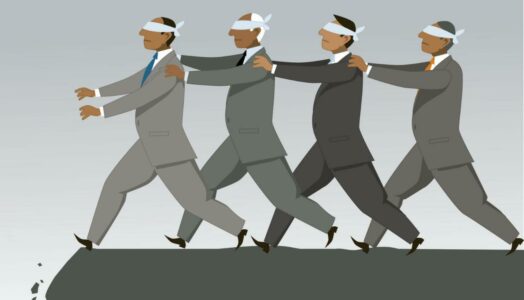the behavior of individuals in a group acting collectively without centralized direction. Herd behavior occurs in animals in herds, packs, bird flocks, fish schools and so on, as well as in humans in demonstrations, riots and general strikes, sporting events, religious gatherings, episodes of mob violence and everyday decision-making, judgement and opinion-forming.1 The ruling elite use paid fake leaders and provocateurs to infiltrate grassroot movements and protests; create fake media polls; manipulated photos and falsify statistics, etc. to impress upon our minds a false reality that leads us to make decisions they want us to make and believe what they want us to believe.
The philosophers Søren Kierkegaard and Friedrich Nietzsche were among the first to criticize what they referred to as “the crowd” (Kierkegaard) and “herd morality” and the “herd instinct” (Nietzsche) in human society. Modern psychological and economic research has identified herd behavior in humans to explain the phenomenon of large numbers of people acting in the same way at the same time. The British surgeon Wilfred Trotter popularized the “herd behavior” phrase in his book, Instincts of the Herd in Peace and War (1914). In The Theory of the Leisure Class, Thorstein Veblen explained economic behavior in terms of social influences such as “emulation,” where some members of a group mimic other members of higher status. In “The Metropolis and Mental Life” (1903), early sociologist George Simmel referred to the “impulse to sociability in man”, and sought to describe “the forms of association by which a mere sum of separate individuals are made into a ‘society’ “. Other social scientists explored behaviors related to herding, such as Sigmund Freud (crowd psychology), Carl Jung (collective unconscious), Everett Dean Martin (Behavior of Crowds) and Gustave Le Bon (the popular mind). Swarm theory observed in non-human societies is a related concept and is being explored as it occurs in human society.
Going Against the Grain (Evading heard behavior when needed)
It takes courage to go against the grain and stand up for what you believe in, know to be true, or is morally right when everyone else is seemingly going a different direction. For groups of animals, there is safety in keeping with the heard. In woodwork it is important to go WITH the grain. However, in life there are often times where going against the grain is the right thing to do.
The true hero is both noble and self-destructive. He or she not only prefers an honorable death to a dishonorable life, but also would rather die young and gloriously than spin out a long and compromised existence loaded with easily gotten (and forgotten) honors. Hector in Homer’s Iliad says: “’Tis true I perish, yet I perish great.” The heroic life is inherently tragic; immortality is its only reward.
Moral courage, as distinct from physical courage, is a civic rather than a military virtue. A person may be afraid of physical harm, but morally fearless. But moral courage has always been less admired than physical courage, because it involves going against the grain. Rulers hate it because it “speaks truth to power,” and crowds are made uncomfortable by it because it confronts their prejudices.
From an ethical perspective, moral courage has been considered the highest form of courage in the liberal age, because it is deliberate, not instinctive. But its value has diminished along with the penalties for displaying it. Opinions once considered courageous are now merely “controversial,” and although they might lead to the loss of one’s job or friends, this is hardly the same as being burned at the stake.




